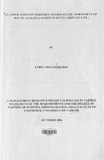| dc.description.abstract | The study set out to find out whether the McKinsey Matrix is applicable as a market assessment tool
within the context of Kenya Airways. The motivation behind the study was the pressure that has
been brought on to airlines by major changes in their operating environment in the recent past, which
have forced them to venture out in search of new routes in order to survive. The fear is that the rush
may have resulted in the opening of unattractive routes that do not deserve resource allocation. The
question of interest, which the researcher sought to answer, was whether there exists a formal
strategic tool that can be used to assess new routes for attractiveness before entry or to assess
existing routes for attractiveness to justify the resources allocated to them.
Data was collected through questionnaires and a few personal interviews. Two separate
questionnaires were sent out. The first one achieved an 87% response rate while the second achieved
a response rate of 91%. A total of 63 questionnaires were sent out and 56 received back resulting in
an overall response rate of 89%. For independence, the first questionnaire was sent to head office
managers seeking weights for the matrix factors while the second one was sent to individual country
managers who scored aspects of their routes against factors weighted in the first questionnaire.
Findings of the research indicate that Kenya Airways' routes fall into 4 of the 9 cells of the
McKinsey Matrix. 52% of the routes fall within the "Grow/Penetrate" cell of the matrix and are
spread across the six regions of the company. Tl1is indicates that they fall in highly attractive
markets in which the airline has high/strong business strength. 10% of the routes fall in the "Invest
for Growth" cell indicating that they are in very attractive markets in which the airline has average
business strength. 31% fall in the "Selective Harvest or Investment" cell. These are routes in markets
where the airline has good business strength but the markets are losing attractiveness. Lastly, 8% fell
in the "Segment and Selective Investment" cell showing that they are in markets of average
attractiveness where the airline has average business strength.
The McKinsey Matrix recommends a mix of resource allocation decisions for the routes that fall into
each cell. For the routes in the "Grow/Penetrate", resource allocation should be geared towards
seeking dominance and growing. The "Invest for Growth" routes should channel their resources
towards identifying weaknesses and building strength so as to gain leadership. In the "Selective
Harvest or Investment" routes, the airline needs to channel resources towards identifying growth
segments and investing strongly in them. Lastly, the matrix recommends that for the routes in the
"Segment and Selective Investment" cell, the airline should identify growth segments, invest
selectively and specialize in them.
The research concluded that the McKinsey Matrix is applicable as a market assessment tool within
the context of Kenya Airways and its recommendations make sense and are applicable to an airline.
Further research needs to be carried out to determine whether the tool can be developed further into
a system that automatically monitors performance of routes periodically once performance data is
up-loaded. | en |

